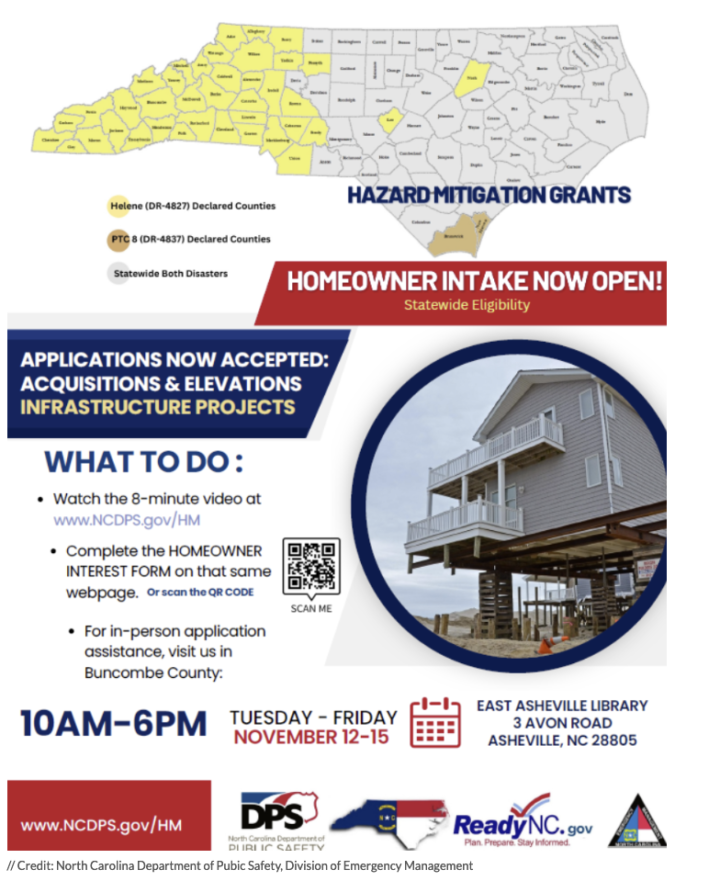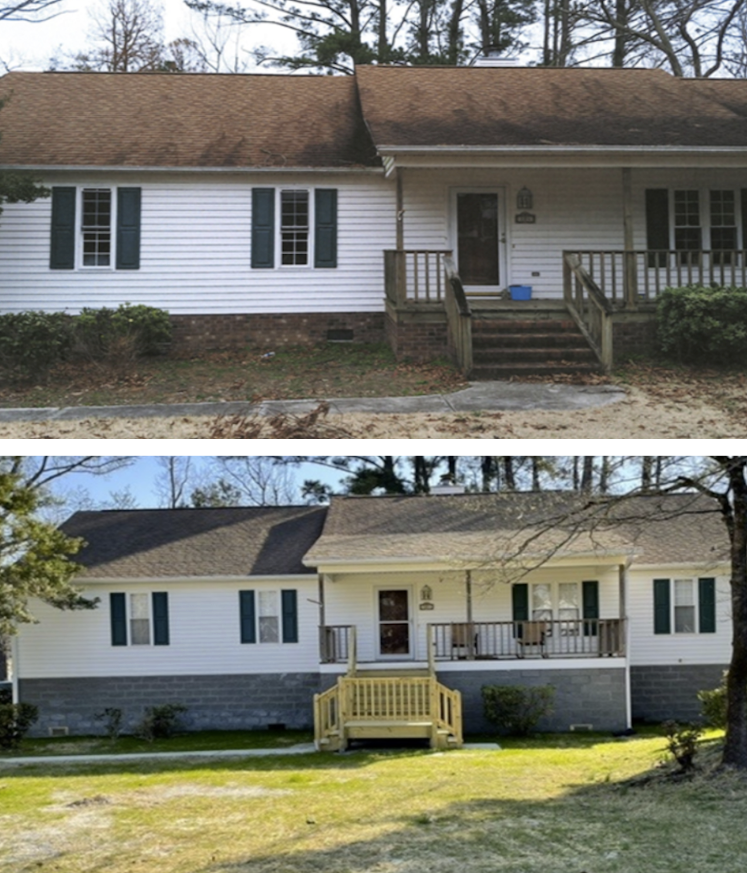by JOHN BOYLE
Local homeowners who lost their homes or sustained serious damage in Helene’s floodwaters can begin applying to a federal program that may buy the home outright, or pay to have it elevated or rebuilt at a higher level.
Steve McGugan, the state of North Carolina’s Hazard Mitigations section chief, explained at the Buncombe County Tropical Storm Helene briefing Friday how the FEMA program works.
The Federal Emergency Management Agency provides the funding for the program, called the Hazard Mitigation Program, which the state administers.
Residents can apply for the program starting Tuesday at the FEMA location at Asheville Mall in the former Gap store location, across from Bath & Body Works. Staff will be on location from 10 a.m. to 6 p.m., Tuesday through Friday, Nov. 12-15.
“We will have a team there that will be able to answer questions, help assist you in filling out a paper application form where we get all your information,” McGugan said. “We’ll also go ahead and check your tax card to make sure we have all the proper names that need to be on the application, and signatures that we will need. We will also verify where you are located within the flood zone.”
FEMA provides funding to the state, which then flows to the community.
 In Buncombe, 900 homes had substantial damage from Helene, with about 300, including 75 commercial properties, totally lost, according to Buncombe County.
In Buncombe, 900 homes had substantial damage from Helene, with about 300, including 75 commercial properties, totally lost, according to Buncombe County.
Three types of assistance
The program offers three types of assistance:
Acquisition: “If your property has been severely damaged and you are located in a flood hazard area and wish to relocate from that flood hazard area, you can sign up for the acquisition program,” McGugan said. “In the acquisition program, your home would be bought just as if you were selling it to another homeowner, and moving away.”
The property would be appraised based on its value the day before the storm struck, in part based on the tax valuation. That gives a base value to work from, and appraisers will also use a “multiplier” provided by the county for homes whose valuations likely have increased, he noted. Additionally, they look at comparable homes that sold before the storm hit to arrive at the appraised amount.
Upon the home’s closing, “our closing official or a closing company would basically pay off your loan, if you have a loan on the house remaining, and then the proceeds would then be handed over to you, just like a normal acquisition process,” McGugan said.
“Once that’s completed, that property would then be deeded over to the county, and the county would retain that property,” McGugan continued. “And that property would not be available to be reoccupied or be reused for housing, but in the future the county can use those properties for such things as parks, greenways, other things in their future plan that benefit the community, as well as assist in being able to prevent future flood damages from occurring.”
Raising the home: Called “Elevations,” this program is basically what it sounds like: lifting the home, typically by 2 feet, to raise it out of the flood zone.
“An elevation project is done when your home may have had a little bit of water on the first floor — one or two feet,” McGugan said.
He showed a home before and after — on a lower brick foundation when it flooded, and then raised to a higher concrete block foundation.
“You would move out of the home — and when I say move out, we will provide you temporary lodging while the construction process takes place,” McGugan said. “You don’t have to move any household goods out, because we pick the house up as is.”
The program can accommodate homes with Americans with Disabilities Act provisions.
Mitigation reconstruction: “Mitigation reconstruction is done when first you requested an elevation, and we came in and determined that your home may be more damaged than was thought, and we cannot safely lift it and elevate it to the new height,” McGugan said.
“The old house would be torn down, a new foundation built that, again, is at an elevated level, and then a new home is built in place of the old home,” McGugan said, noting that these are not custom homes but contractor grade.
The state would “move your furniture back in, set it back up, and you would move back in again,” McGugan said.
What about the cost?
McGugan stressed that there is no cost to homeowners for these programs. For example, on acquisition, FEMA pays 75 percent of the cost to acquire and demolish the property and restore the property to green space. The state pays the other 25 percent.
“There is no cost to the homeowner for this program,” McGugan said.
Are most applications accepted?
McGugan said that a very high percentage of applications are accepted. He noted that since Hurricane Florence struck North Carolina in 2018, “if a homeowner has applied and stayed with us and did not walk away from the program, we have been able to complete their home.”
The program is voluntary, and homeowners can walk away at any point, he said, but the success rate in getting applications approved is very high.
“I will tell you that at this point, I have never not been able to get a home approved,” McGugan said. “There are many rules that go with this program and many ways that we can work together in the application to always meet a benefit-cost ratio of one, which is requirement for FEMA to approve it — that we show that the benefit-cost ratio of doing an acquisition or an elevation or a mitigation reconstruction is one.”
The state has “a lot of tools” to reach that level.
“So I have not had any denied based upon the value of a home,” McGugan said. “Really, the only thing that prevents a home from being approved is if there are issues with the title — we can’t get a clear title.”
Asheville Watchdog is a nonprofit news team producing stories that matter to Asheville and Buncombe County. John Boyle has been covering Asheville and surrounding communities since the 20th century. You can reach him at (828) 337-0941, or via email at jboyle@avlwatchdog.org. The Watchdog’s local reporting during this crisis is made possible by donations from the community. To show your support for this vital public service go to avlwatchdog.org/support-our-publication/.




Before you comment
The comments section is here to provide a platform for civil dialogue on the issues we face together as a local community. Xpress is committed to offering this platform for all voices, but when the tone of the discussion gets nasty or strays off topic, we believe many people choose not to participate. Xpress editors are determined to moderate comments to ensure a constructive interchange is maintained. All comments judged not to be in keeping with the spirit of civil discourse will be removed and repeat violators will be banned. See here for our terms of service. Thank you for being part of this effort to promote respectful discussion.